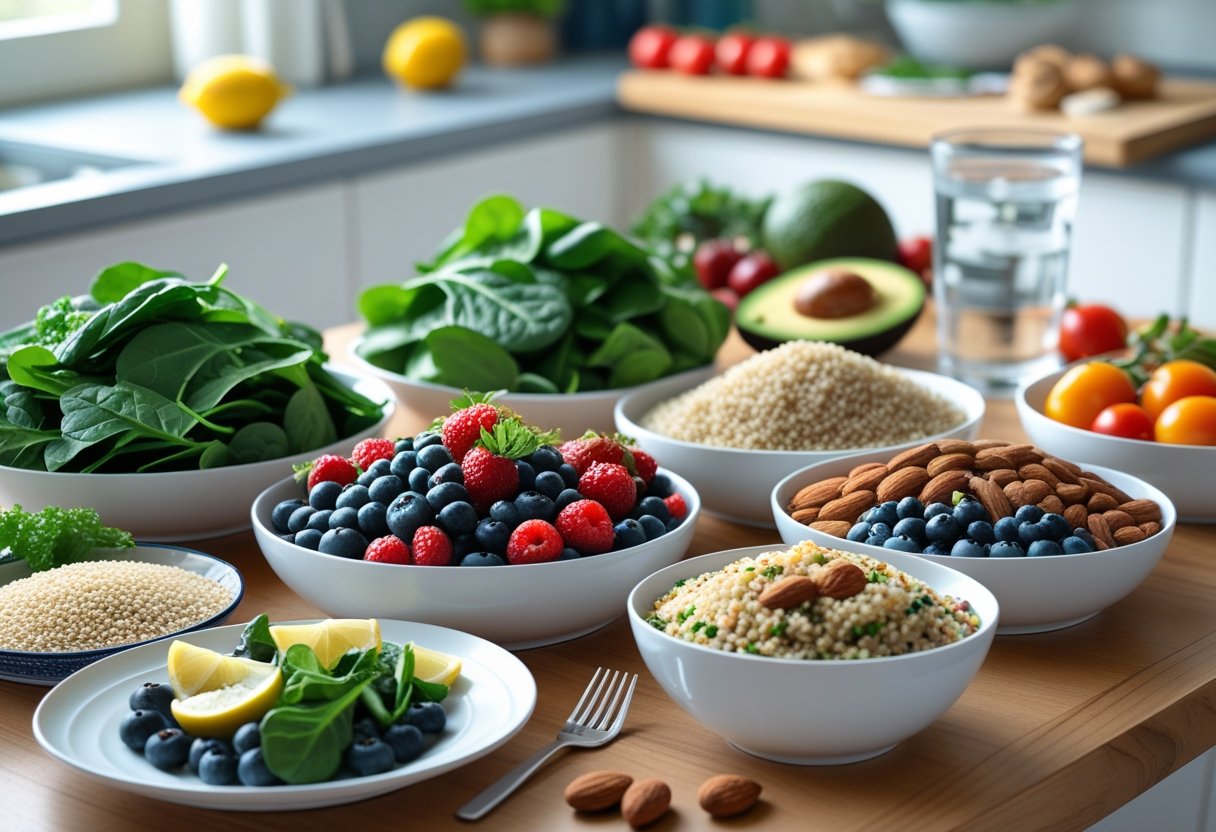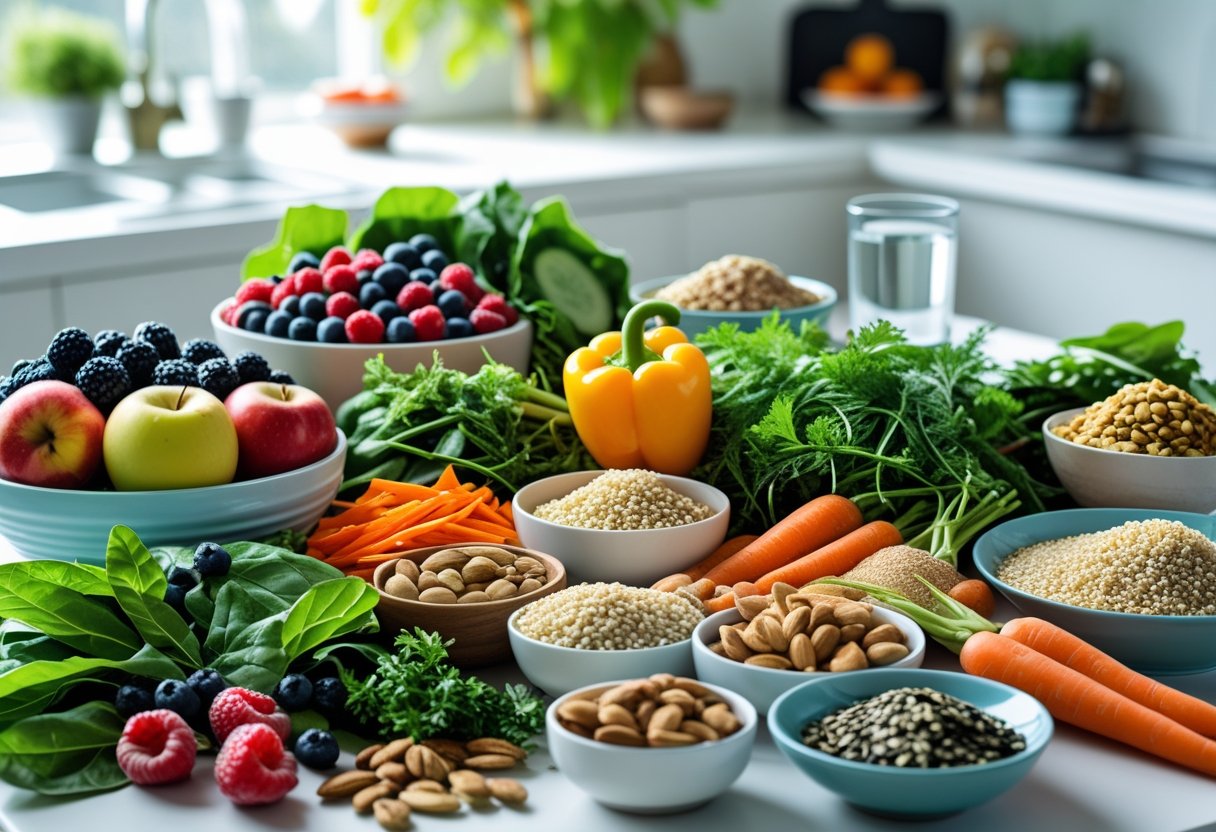Controlling blood sugar through diet is essential for maintaining overall health, especially for those at risk of diabetes. The best diets to manage blood sugar focus on whole foods, low glycemic index options, and balanced nutrients that keep glucose levels steady. These diets help prevent spikes and drops in blood sugar, supporting long-term energy and reducing health risks.

Many effective diets share common features like plenty of fiber, lean proteins, and healthy fats while limiting refined sugars and processed foods. They emphasize natural ingredients that slow digestion and improve insulin sensitivity. Understanding these principles can help anyone make smarter food choices for better blood sugar control.
Choosing the right diet is not about strict restrictions but about steady, sustainable habits. Learning which foods promote stability can guide better meal planning and blood sugar management over time, making daily health easier to maintain. For more detailed guidance, consider exploring specific eating plans proven to support balanced glucose levels.
Understanding Blood Sugar and Its Impact

Blood sugar, or glucose, is a key energy source for the body. Keeping it within a healthy range is vital for good health. When blood sugar levels are balanced, the body works well. When they are not, serious health issues can arise.
How Blood Sugar Levels Are Regulated
Blood sugar levels rise when a person eats foods containing carbohydrates. The digestive system breaks these down into glucose, which then enters the bloodstream. The hormone insulin, made by the pancreas, helps move glucose from the blood into cells where it is used for energy.
When blood sugar is too low, the pancreas releases another hormone called glucagon, which signals the liver to release stored glucose. This balance between insulin and glucagon keeps blood sugar levels stable. Problems with insulin production or response can cause blood sugar to become too high or too low.
Consequences of Poor Blood Sugar Control
If blood sugar is often too high, it can damage blood vessels, nerves, and organs over time. This damage increases the risk of heart disease, kidney disease, vision problems, and nerve pain. High blood sugar also makes wounds heal slower and infections more likely.
Low blood sugar can cause dizziness, confusion, shaking, and in severe cases, loss of consciousness. Frequent blood sugar swings can harm overall health and make daily life difficult. Consistently managing blood sugar supports long-term wellbeing.
Factors Affecting Blood Sugar
Many things can affect blood sugar levels. Foods rich in carbohydrates raise blood sugar the most. Eating carbohydrate foods high in fiber can slow this rise and improve control. Physical activity helps lower blood sugar by increasing insulin sensitivity.
Other factors include stress, illness, and certain medications. Insulin doses need to match carbohydrate intake for people on insulin therapy. Tracking carb intake and understanding how different foods affect blood sugar can improve control and reduce risks.
For more on how diet impacts blood sugar and how to balance it, see this beginner’s guide to blood sugar and diet.
The Importance of Diet in Blood Sugar Management

Controlling blood sugar depends heavily on what a person eats. Certain nutrients affect blood sugar levels more than others. Choosing the right foods and knowing how to combine them helps keep glucose stable throughout the day.
Role of Macronutrients
Macronutrients—carbohydrates, proteins, and fats—each impact blood sugar differently. Carbohydrates have the most immediate effect because they break down into glucose. Consuming complex carbs like beans and lentils slows glucose release, preventing spikes.
Protein helps slow digestion and stabilizes blood sugar. Including seafood or lean meats provides protein that aids insulin function without raising glucose levels. Healthy fats, such as those in nuts or olive oil, do not raise blood sugar but can improve overall health.
Balancing these macronutrients in meals supports more steady glucose and better insulin sensitivity.
Glycemic Index and Glycemic Load
The glycemic index (GI) ranks carbohydrates based on how quickly they raise blood sugar. Foods with a low GI raise glucose slowly, which is beneficial for blood sugar control.
Glycemic load (GL) considers both GI and the amount of carbs eaten. It shows the overall impact a food has on blood sugar. Low-GI and low-GL foods help prevent sharp blood sugar changes.
Eating more foods with low GI and GL, such as whole grains, vegetables, and legumes, can improve blood sugar management.
Balancing Meals for Stable Glucose
Balanced meals mix macronutrients and include fiber-rich foods to maintain steady glucose levels. Fiber slows digestion and improves insulin response. Foods high in soluble fiber, like oats and lentils, are especially helpful for blood sugar control.
A typical balanced plate might have:
- 1/2 vegetables or salad
- 1/4 lean protein like fish or beans
- 1/4 whole grains or starchy vegetables
This approach limits blood sugar spikes and supports long-term health.
Best Diets to Control Blood Sugar

Some diets focus on reducing sugar spikes by emphasizing whole foods, fiber, and balanced nutrients. Others limit specific foods like carbs or animal products to improve blood sugar control and insulin function.
Mediterranean Diet
The Mediterranean Diet highlights fruits, vegetables, whole grains, nuts, and olive oil. It encourages eating fish and poultry instead of red meat. This diet is rich in fiber and healthy fats, which help improve insulin sensitivity.
People following this diet tend to have lower blood sugar and a reduced risk of type 2 diabetes. It also supports heart health by lowering bad cholesterol. The diet’s emphasis on variety and fresh foods makes it easier to stick to long term.
DASH Diet
The DASH (Dietary Approaches to Stop Hypertension) Diet was designed to lower blood pressure but also helps with blood sugar control. It focuses on vegetables, fruits, whole grains, and low-fat dairy.
This diet is low in saturated fat, cholesterol, and added sugars. Its balance of nutrients supports weight management and reduces insulin resistance. People on the DASH diet often experience better blood sugar levels and improved overall health.
Low-Carbohydrate Diets
Low-carb diets limit foods high in sugar and starches, like bread, pasta, and sweets. Reducing carb intake lowers blood sugar and decreases the demand on insulin.
Examples include ketogenic and Atkins diets, which promote fats and proteins instead of carbs. Studies show these diets can help lower blood sugar quickly and improve diabetes management. However, long-term effects vary, so monitoring by a healthcare professional is recommended.
Plant-Based Diets
Plant-based diets focus on fruits, vegetables, legumes, nuts, and whole grains while minimizing or excluding animal products. These diets are rich in fiber, which slows sugar absorption and improves blood sugar control.
They are also low in unhealthy fats and calories, aiding in weight control. People who follow plant-based eating often have lower risk for type 2 diabetes and heart disease. This diet may require careful planning to ensure enough protein and certain nutrients.
Key Foods for Blood Sugar Regulation
Certain foods help keep blood sugar levels steady by slowing digestion, improving insulin sensitivity, or providing essential nutrients. These foods include those rich in fiber, healthy fats, lean proteins, and fruits and vegetables with low glycemic impact.
High-Fiber Foods
Fiber is crucial for controlling blood sugar because it slows the absorption of sugar in the bloodstream. Soluble fiber, found in foods like oats, barley, and beans, forms a gel in the gut that helps reduce blood sugar spikes after meals.
Eating high-fiber foods also supports gut health, which can influence metabolic processes linked to blood sugar control. Vegetables like broccoli and Brussels sprouts are good fiber sources that add volume without adding calories.
Including a mix of soluble and insoluble fiber can improve insulin response and prevent sudden blood sugar rises. Fiber-rich diets are linked to better long-term blood sugar management according to research on foods that help regulate glucose levels.
Healthy Fats
Healthy fats, especially unsaturated fats found in nuts, seeds, avocados, and olive oil, play a vital role in managing blood sugar. They slow digestion and improve how the body uses insulin.
Adding these fats to meals can reduce the glycemic load, meaning blood sugar rises more slowly after eating. Omega-3 fatty acids from fatty fish like salmon also support heart health, which is important for people managing blood sugar.
It’s better to avoid trans fats and limit saturated fats, which can harm insulin function. Instead, focusing on monounsaturated and polyunsaturated fats helps stabilize blood sugar and improve overall metabolic health.
Lean Proteins
Lean proteins such as chicken breast, turkey, eggs, tofu, and legumes help control blood sugar by providing steady energy without causing spikes in glucose. Protein slows stomach emptying, lowering how fast sugar enters the bloodstream after a meal.
Legumes are especially beneficial, as they combine protein with fiber, enhancing blood sugar control further. Seafood offers not only protein but also heart-healthy fats that help with insulin sensitivity.
Consuming lean proteins in balanced meals may reduce cravings and overeating, which affects blood sugar stability. Choosing proteins low in unhealthy fats supports both blood sugar regulation and cardiovascular health.
Low Glycemic Fruit and Vegetables
Fruits and vegetables with a low glycemic index raise blood sugar slowly, allowing better control. Examples include berries, cherries, apples, pears, leafy greens, and cruciferous vegetables.
These foods often contain antioxidants and minerals like magnesium, which improve insulin function and reduce inflammation. Eating a variety of colorful vegetables adds vital nutrients without causing rapid blood sugar changes.
Avoid fruits and vegetables high in sugar or starch, such as grapes, bananas, or potatoes, when focusing on blood sugar control. Emphasizing low glycemic options helps maintain steady glucose levels throughout the day.
For more details on effective foods to lower blood sugar, see 17 Foods to Lower Your Blood Sugar.
Foods and Eating Habits to Avoid
Certain foods and eating patterns can cause blood sugar to spike or become unstable. Avoiding these can help maintain better control of blood sugar levels and reduce the risk of complications.
Refined Sugars and Processed Foods
Refined sugars, like those in candy, soda, and baked goods, quickly raise blood sugar. These foods often lack fiber and nutrients, which slows sugar absorption. Processed foods usually contain added sugars and unhealthy fats that worsen blood sugar control.
Examples include:
- Sugary drinks
- White bread and pastries
- Packaged snacks
Cutting back on these foods can reduce sudden blood sugar spikes. Choosing whole grains and natural sweeteners helps keep levels steadier.
High-Glycemic Snacks
Snacks with a high glycemic index (GI) cause rapid blood sugar increases. Foods such as potato chips, white rice, and certain cereals fit in this category. High-GI snacks provide a quick energy boost but often lead to crashes later.
Consuming low-GI or mixed meals with fiber and protein minimizes blood sugar swings. Healthy snack options include:
- Nuts
- Raw vegetables
- Greek yogurt
Replacing high-GI snacks with these choices supports more stable blood sugar.
Irregular Meal Patterns
Skipping meals or eating at inconsistent times can disrupt blood sugar control. When meals are delayed or missed, blood sugar may drop too low or rebound sharply after eating. This makes managing levels more difficult.
Regular eating habits with balanced meals every 3-4 hours help maintain steady glucose. Planning meals and snacks avoids extreme highs and lows. This is especially important for people managing diabetes or prediabetes.
Lifestyle Factors That Support Blood Sugar Control
Managing blood sugar involves more than just diet. Daily habits like exercise, stress levels, and sleep quality all play key roles in keeping blood sugar steady and healthy.
Physical Activity and Exercise
Regular physical activity helps the body use insulin more efficiently. When muscles contract during exercise, they absorb glucose without needing extra insulin. This lowers blood sugar levels naturally.
Both aerobic exercises like walking or cycling and strength training can improve blood sugar control. Experts suggest aiming for at least 150 minutes of moderate exercise per week, spread out over several days.
Even short bursts of activity, such as 10-minute walks after meals, can reduce blood sugar spikes. Staying active also supports weight management, which can improve insulin sensitivity.
Stress Management
Stress triggers the release of hormones like cortisol that raise blood sugar. Chronic stress keeps these hormones high, making blood sugar harder to control.
Effective stress management techniques include deep breathing, meditation, and mindfulness. Regular practice helps reduce cortisol levels and improve overall blood sugar stability.
Building a daily routine that incorporates relaxation breaks also helps. Engaging in hobbies, spending time outdoors, or connecting with friends can reduce stress impact.
Quality Sleep
Poor sleep affects blood sugar by disrupting hormones that regulate glucose. Studies show that lack of sleep can increase insulin resistance and hunger hormones.
Adults should aim for 7-9 hours of quality sleep each night. Good sleep habits include keeping a consistent bedtime, avoiding screens before sleep, and creating a restful environment.
Addressing sleep problems like sleep apnea or insomnia is also important. Consulting a healthcare provider can help improve sleep and, in turn, aid blood sugar control.
Practical Tips for Long-Term Success
Controlling blood sugar takes consistent effort in everyday habits. Proper meal planning, smart shopping choices, and tracking progress are key to maintaining healthy levels over time.
Meal Planning Strategies
Planning meals ahead helps keep blood sugar steady by avoiding sudden spikes. A balanced plate includes lean proteins, high-fiber vegetables, and whole grains. For example, pairing grilled chicken with broccoli and quinoa supports slower sugar absorption.
Spacing meals evenly during the day prevents low or high blood sugar. Eating smaller, frequent meals instead of large ones helps the body manage glucose better.
Including foods that are rich in magnesium, fiber, and healthy fats also supports control. Avoiding processed sugars and refined carbs reduces quick sugar surges.
Smart Grocery Shopping
Choosing the right foods starts at the grocery store. Stick to the perimeter where fresh produce, meats, and dairy are located. Avoid aisles with mostly processed and packaged snacks.
Look for high-fiber and low glycemic index options, like beans, lentils, and whole grains. These help maintain steady blood sugar levels throughout the day. Reading labels for added sugars and simple carbs helps avoid hidden spikes.
Stock up on protein sources like fish, poultry, and nuts. These provide energy without raising blood sugar rapidly.
Tracking Progress and Adjustments
Keeping a food and blood sugar log helps identify what works and what doesn’t. Recording meals, portion sizes, and timings can show patterns in blood sugar changes.
Regularly checking blood sugar at different times—before and after meals—is important to see how foods affect levels. This tracking allows adjustments in diet or meal timing faster.
He or she can use apps or simple notebooks for this. Reviewing this information with a healthcare professional helps tailor the diet further to maintain control.
